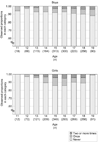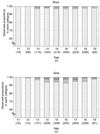Sex differences in developmental trends of suicide ideation, plans, and attempts among European American adolescents
- PMID: 21034208
- PMCID: PMC2995258
- DOI: 10.1521/suli.2010.40.5.451
Sex differences in developmental trends of suicide ideation, plans, and attempts among European American adolescents
Abstract
Although suicide ideation, plans, and attempts increase during adolescence, it remains unclear whether boys' and girls' risk for these outcomes peaks at different ages. We used longitudinal categorical data (never, once, 2+ times) from the Family Transitions Project (N = 1,248 rural European Americans, ages 11-19) to investigate whether yearly prevalence rates of adolescent suicidal episodes follow different patterns by sex. Multiple-group growth models revealed that peak levels of past-year ideation and plans occurred during mid adolescence for girls, but slowly increased through late adolescence for boys. We found that prevalence patterns for attempts were very similar for boys and girls, with both increasing through mid adolescence and then declining, although girls' risk declined slightly more rapidly. This information may help alert gatekeepers to developmental periods during which boys and girls are particularly vulnerable to suicide-related experiences, and also may help inform the timing of preventive efforts.
Figures






References
-
- Arnett JJ. Conceptions of the transition to adulthood: Perspectives from adolescence through midlife. Journal of Adult Development. 2001;8(2):133–143.
-
- Brener ND, Kann L, Kinchen SA, Grunbaum JA, Whalen L, Eaton D, Hawkins J, Ross JG. Methodology of the youth risk behavior surveillance system. MMWR Recomm Rep. 2004;53(RR-12):1–13. - PubMed
-
- Caspi A, Lynam D, Moffitt TE, Silva PA. Unraveling girls' delinquency: Biological, dispositional, and contextual contributions to adolescent misbehavior. Developmental Psychology. 1993;29(1):19–30.
-
- Centers for Disease Control and Prevention. CDC surveillance summaries. MMWR. 1995 March 24;44(SS-1)
-
- Centers for Disease Control and Prevention. Web-based Injury Statistics Query and Reporting System (WISQARS) [Data file] 2008. [Retrieved September 29, 2008]. from http://webappa.cdc.gov/sasweb/ncipc/mortrate10_sy.html.
Publication types
MeSH terms
Grants and funding
- R01 MH062989/MH/NIMH NIH HHS/United States
- MH051361/MH/NIMH NIH HHS/United States
- HD027724/HD/NICHD NIH HHS/United States
- DA05347/DA/NIDA NIH HHS/United States
- MH59355/MH/NIMH NIH HHS/United States
- MCJ-109572/PHS HHS/United States
- MH19734/MH/NIMH NIH HHS/United States
- R01 HD047573/HD/NICHD NIH HHS/United States
- MH48165/MH/NIMH NIH HHS/United States
- R01 HD051746/HD/NICHD NIH HHS/United States
- HD051746/HD/NICHD NIH HHS/United States
- HD047573/HD/NICHD NIH HHS/United States
- T32 MH018387/MH/NIMH NIH HHS/United States
- R01 MH051361/MH/NIMH NIH HHS/United States
- MH62989/MH/NIMH NIH HHS/United States
- MH43270/MH/NIMH NIH HHS/United States
- T32 MH019734/MH/NIMH NIH HHS/United States
- K05 MH000567/MH/NIMH NIH HHS/United States
- MH00567/MH/NIMH NIH HHS/United States
LinkOut - more resources
Full Text Sources
Medical
Miscellaneous

